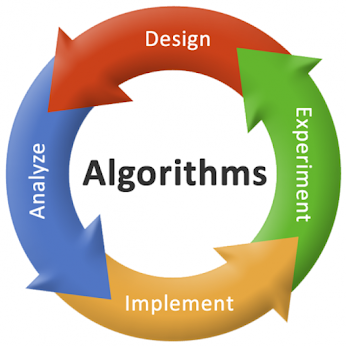ALGORITHM
What is Algorithm
An algorithm is a step-by-step procedure for solving a
problem or achieving a specific task. It is a set of instructions that can be
followed by a computer or a human being to accomplish a specific task.
Algorithms can be expressed in any programming language and can be as simple
as a few lines of code or as complex as thousands of lines of code. They are
used in a wide range of applications, such as search engines, data compression,
image processing, and machine learning. The efficiency and correctness of an
algorithm are important factors to consider when designing an algorithm.
Algorithm can be categorized in different types like Brute force, Greedy,
Dynamic Programming and Divide and Conquer, depending on how they approach the
problem.
Example of Algorithm
An example of an algorithm
can be a sorting algorithm like the Bubble sort, which is used to sort an array of
numbers in ascending order.
- Compare the first element of the array with the second element.
- If the first element is larger than the second element, swap them.
- Move on to the next pair of elements and repeat step 2.
- Repeat steps 2 and 3 for the entire array.
- Repeat the entire process until the array is sorted.
This algorithm
describes the steps required to sort an array using the bubble sort method and
can be implemented in any programming language.
Types of Algorithm
There are several types of algorithms, each with its own
characteristics and uses. Some common types of algorithms include:
- Brute Force: Brute force algorithms are straightforward and easy to implement, but may not be the most efficient. They typically involve trying all possible solutions to a problem until the correct one is found.
- Greedy: Greedy algorithms make the locally optimal choice at each step, with the hope of finding a globally optimal solution. They are often used for optimization problems.
- Dynamic Programming: Dynamic programming algorithms break a problem down into smaller subproblems that can be solved independently, and then combine the solutions to the subproblems to solve the original problem.
- Divide and Conquer: Divide and conquer algorithms break a problem down into smaller subproblems, solve the subproblems independently, and then combine the solutions to the subproblems to solve the original problem.
- Backtracking: Backtracking algorithms are a type of recursive algorithm that builds solutions incrementally, and then backtracks when a solution cannot be found.
- Heuristics: Heuristics are algorithms that do not guarantee an optimal solution, but can be used to quickly find a good solution to a problem.
- Randomized Algorithm: A randomized algorithm is an algorithm that makes random choices during its execution. They are often used to solve optimization problems, where the goal is to find the best solution among a large number of possible solutions.
- Approximation Algorithm: Approximation algorithms are used to find approximate solutions to optimization problems, where an exact solution cannot be found in a reasonable amount of time.
These are some of the common types of algorithms, but there are many more,
and new ones are being developed all the time. The choice of algorithm will
depend on the problem you are trying to solve and the resources available to
solve it.
Advantage of Algorithm
There are several advantages of using algorithms:
- Efficiency: Algorithms can be designed to be efficient in terms of time and space, allowing them to solve complex problems in a reasonable amount of time.
- Consistency: Algorithms are step-by-step instructions that are followed in a consistent manner, reducing the chance of errors and increasing the reproducibility of results.
- Simplicity: Algorithms can be designed to be simple and easy to understand, which makes them easy to implement and maintain.
- Scalability: Algorithms can be designed to be scalable, meaning they can handle large inputs and outputs, making them suitable for use in big data and other large-scale applications.
- Reusability: Algorithms can be reused in different situations, which can save time and resources.
- Automation: Algorithms can be used to automate tasks, which can save time and labor, and reduce the chance of human error.
- Optimization: Algorithms can be used to optimize processes and systems, making them more efficient and cost-effective.
- Problem-solving: Algorithms can be used to solve a wide range of problems in various fields including computer science, mathematics, engineering, and operations research.
Overall, algorithms are powerful tools that can be used to
solve complex problems and automate tasks, making them an essential component
of modern technology and research.
Disadvantage of Algorithm
While algorithms have many advantages, they also have some limitations and disadvantages:
- Complexity: Some algorithms can be complex and difficult to understand, which can make them difficult to implement and maintain.
- Resource Intensive: Some algorithms can be resource-intensive, requiring large amounts of memory or processing power, which can make them impractical for use on certain devices or in certain situations.
- Limited to the specific problem: Algorithms are designed to solve specific problems and may not be able to solve other related or unrelated problems.
- Brittle: Algorithms can be brittle and may not perform well in certain edge cases or when the input data is unexpected.
- Local Optimization: Some algorithms like greedy algorithms may not be able to find the global optimal solution for a problem.
- No guarantee of Correctness: There is no guarantee that an algorithm will always produce the correct or optimal solution, even if it terminates and runs successfully.
- Time complexity: Some algorithm have a high time complexity which means they take a longer time to execute, which can be a limitation in real-time systems.
- Randomized Algorithm: Randomized algorithms may not produce the same results each time they are run.
In summary, algorithms can be powerful tools for solving
problems and automating tasks, but they also have their limitations and may not
always be the best solution for a particular problem or situation. It's
important to carefully consider the resources available, the problem to be
solved, and the desired outcome when selecting and implementing an algorithm.


Comments
Post a Comment